If you neglect your traps and fail to strengthen them, you can suffer from poor posture, decreased performance, and even injury.
Shrug exercises are a great way to strengthen the muscles of the upper back, shoulders, and trap.
I used to think shoulder shrugs were just for bodybuilders, but I was wrong.
After adding them to my workouts, I noticed that my trap size and strength increased, and I could lift heavier weights during workouts.
In this ultimate guide, we’ll explain everything you need to know:
- What is a shoulder shrug
- How to perform
- Benefits of shrug exercises
- Benefits of shrugging exercise
- Best shoulder shrug exercises and How to do them correctly

- What Are Shoulder Shrugs?
- Shoulder Shrug Muscles Worked
- How To Do Shoulder Shrug
- Tips and Techniques
- Shoulder Shrug Variations and Modifications
- 1. Dumbbell Shrug
- 2. Incline Dumbbell Shrug
- 3. Barbell Shrug
- 4. Smith Machine Shrug
- 5. Behind-the-Back Barbell Shrug
- 6. Machine Shrug (Gripless Shrug)
- 7. Cable Shrug
- Shoulder Shrug Benefits
- Shoulder Shrug Workout Routine
- I. During Shoulder Workout
- II. During Pull Workout Split.
- III. During Upper Body Workout
- FAQs
- How many sets and reps of shrugs
- What muscles does a shrug work?
- Are shrugs actually effective?
- Are shrugs a shoulder or back exercise?
- Is shrugs push or pull?
- Should I do shrugs on push or pull day?
- Takeaway
- 18 Best Trap Exercises for Mass and Strength
What Are Shoulder Shrugs?
Shrugs, also known as shoulder shrugs, are isolation exercises that target the trapezius muscles. They help build the upper portion of the trapezius and make a physique more impressive.
If you have a desk job, you likely spend a large part of your day with your neck leaned forward, your shoulders depreciated, and your eyes focused on a screen.
Over time, this posture can take quite a toll on your neck and shoulder muscles.
Shoulder shrugging is an effective, easy-to-form exercise that strengthens the trapezius and improves posture.
Studies and many physiotherapists also recommend this exercise when someone is experiencing neck or shoulder pain.
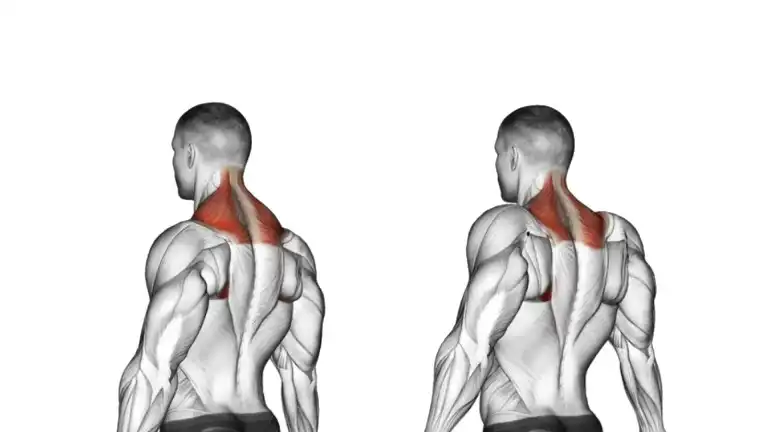
Shoulder Shrug Muscles Worked
Shoulder shrugs are a popular exercise choice for strengthening your upper back, shoulder muscles, neck, and upper arms.
- The main muscles that shoulder shrugs target are the upper traps,
- Other muscles worked are several other upper back muscles, including the middle traps, lower traps, and rhomboids.

How To Do Shoulder Shrug
Shoulder shrugs can be performed with or without weights.
If you are a beginner, you should start with bodyweight shoulder shrugs, then gradually increase the weight.
- Stand with your feet flat on the ground.
- Keep your ears, shoulders, and hips aligned.
- Your arms are by your sides.
- If you’re using weight for this movement, hold it in your hands, palms facing each other.
- Keep your chin up, your neck should be straight, and your gaze should be straight ahead.
- Raise both of your shoulders as high as you can, towards your ear as you can.
- Slow down the movement so that you feel some resistance to your muscles.
- Hold at the top moment or count 3 to 5, then return to the starting position.
- Do 3 sets of 10 to 20 repetitions.
Tips and Techniques
- Maintain a tall posture with your chest open and shoulders relaxed.
- Do not move your shoulders too quickly when you shrug.
- Avoid rolling your shoulders forward or backward during the shrug. Focus on a straight up-and-down motion.
- Avoid arching the lower back during the exercise.
- Ensure you carefully lift your shoulders before dropping them back down in the same vertical direction.
- Adding a pause at the top of the movement can help to enhance the mind-muscle connection.
- Exhale as you shrug up, inhale as you lower.
- Remember to warm up before exercise and stretch afterward to avoid any workout injuries.
- You should allow at least 36 to 48 hours of rest before training the same muscle groups to allow for sufficient recovery.
- Your results will ultimately be based on your ability to recover from your workouts adequately.
Now, let’s get into the best shoulder shrug exercises for strength and hypertrophy of the traps, using various types of fitness equipment.
Want to take your gains to the next level? Discover your daily calorie needs with our free TDEE calculator
Shoulder Shrug Variations and Modifications
You can start to incorporate variations and modifications into your routine once you’ve mastered the basic shoulder shrug.
Here are the best shoulder shrug exercises you can do with a dumbbell, barbell, cable, and smith machine to develop massive traps.
1. Dumbbell Shrug
The dumbbell shrug is a variation and one of the best exercises to build bigger, stronger trapezius muscles.
It is a simple yet effective exercise that strengthens the shoulders, upper back, and neck muscles. They are suitable for both beginners and pros.
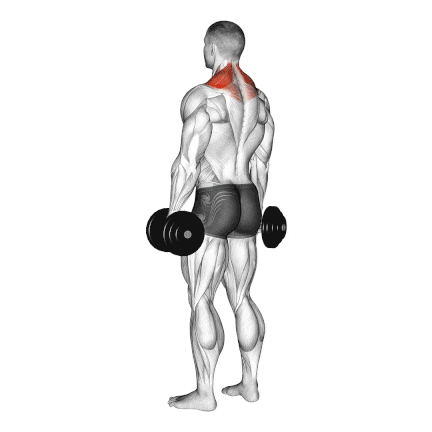
How To Do It
- Stand with your feet shoulder-width apart, holding a dumbbell in each hand.
- Keep your shoulders relaxed and your core engaged.
- Inhale and lift your shoulders towards your ears, making a shrugging motion.
- Hold the contraction for a second or two.
- Then exhale and lower your shoulders back down to the starting position.
- Hold the shrug for a second, then slowly lower the dumbbells back down to the starting position.
- Repeat for 10–12 repetitions for 2–3 sets.
2. Incline Dumbbell Shrug
Incline dumbbell shrug is a variation of dumbbell shrug exercises that strengthen the upper back, part of the trapezius, and neck region.
This shrugging variation will shift emphasis to the upper traps and the upper portion of the middle traps.
Your chest being pressed on the bench will make it difficult to use momentum to drive the weight up.

How To Do It
- You can sit on an adjustable-incline bench.
- Hold the dumbbells with a neutral grip at your sides and lie chest-down on an incline bench.
- Slowly shrug your shoulders up toward your ears.
- At the top, pause momentarily and slowly lower the weights back to the starting position.
3. Barbell Shrug
Barbells allow for the heaviest lifting potential compared to dumbbells or cable variations. This makes barbell Shrug a great choice for experienced lifters looking to build bigger traps.
I’ve always found that barbell shrugs are the fastest way to get a good burn in my traps.
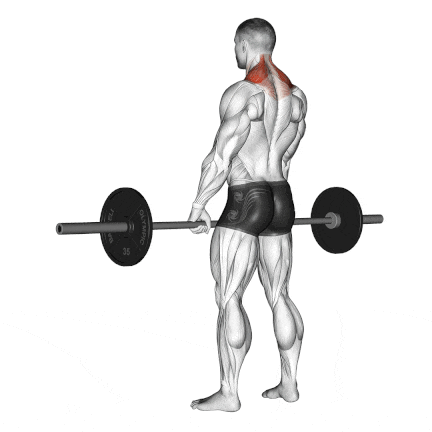
How To Do It
- Stand with feet placed shoulder-width apart.
- Grip the barbell with your hands facing downwards in a pronated grip.
- Raise your shoulders without bending the elbows as far as possible, getting them closer to your ears.
- Hold the contraction and squeeze for a brief second.
- Slowly lower the barbell down to the starting position.
4. Smith Machine Shrug
There are many ways to do the barbell shrug. One way is using a machine called the Smith machine. The Smith machine’s fixed path makes it easy to balance the weight. It’s good for you if you’re new to it and don’t have enough balance.
I like to use the Smith machine shrug when I’m tired and my stabilizing muscles are tired. It lets me do a hard trap workout without worrying about breaking my form.
It is usually performed for moderate to high reps, such as 8-12 reps per set or more, as part of shoulder or trap-focused training.
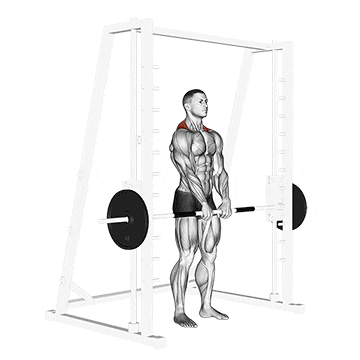
How To Do It
- Hold the unlatched bar with an overhand grip in front of your thighs.
- Both your hands and your feet should be shoulder-width apart.
- Lift your shoulders toward your ears as high as possible.
- Hold the contraction for a second before lowering the bar back to the starting position.
5. Behind-the-Back Barbell Shrug
The barbell behind-the-back shoulder shrug is one of the variations of shrugging exercises to target the upper traps.
Having the bar behind you helps keep your shoulders pulled up and back instead of rounded forward.
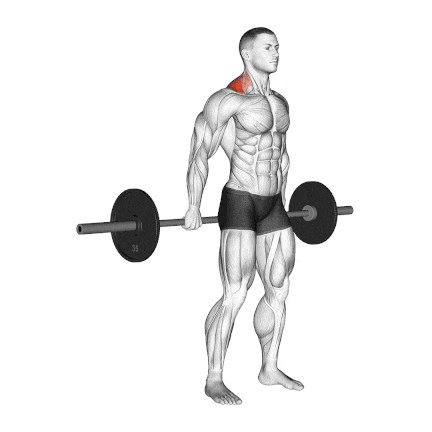
How To Do It
- Stand while holding a barbell with an overhand grip behind your thighs.
- Both your hands and your feet should be shoulder-width apart.
- Lift your shoulders up towards your ears.
- Hold the contraction for a second and then lower the bar back.
6. Machine Shrug (Gripless Shrug)
The gripless shrug is the best shrugging exercise variation because it doesn’t depend on your grip strength to work the traps.
It also allows for a slight increase in the range of motion compared to barbell or dumbbell shrugs.
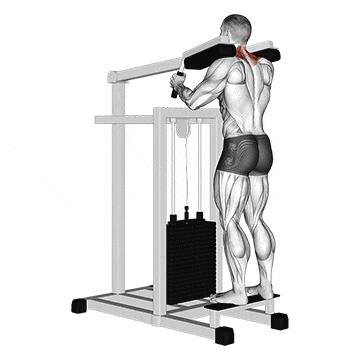
How To Do It
- Stand inside the standing calf raise machine with your shoulders under the pads.
- Grab the handles for stability, although this isn’t necessary.
- Exhale as you slowly raise your shoulders as high as you can.
- Hold for a count of two. Inhale as you lower your shoulders to the starting position.
7. Cable Shrug
One of the benefits of doing cable shrugs is that they provide constant tension throughout the exercise motion.
Unlike dumbbells or barbells, where gravity reduces resistance at specific points, cables provide a continuous pull.
This leads to greater muscle activation and a more challenging workout. I really like this trap workout and have to do it during my trap workout.
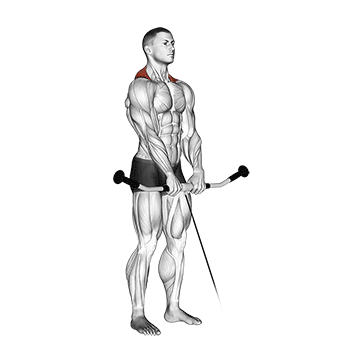
How To Do It
- Grab a cable bar attachment that is attached to a low pulley.
- Your hands should be shoulder-width apart or slightly wider if you wish. Your hands should be facing down.
- Stand close to the pulley and extend your arms in front of you while holding the bar.
- Raise your shoulders and lift the bar as high as you possibly can.
- Hold the contraction at the top for a second.
- Slowly lower the bar to its starting position.
Shoulder Shrug Benefits
There are benefits to properly done shoulder shrugging.
- It helps you to improve your posture.
- Increase the stability of the neck muscles.
- It helps to boost the strength of your shoulder
- Increased upper back muscle strength.
- Improved sports performance
- A study has shown that shrugging helps relieve shoulder and neck pain.
- The chronic neck and shoulder pain has been reduced.
- Strong grips are essential for shrug exercises, which can help improve grip strength.
- Shoulder shrugs are also a great stress reliever.
- Shrugs help stabilize the trap muscles responsible for shoulder elevation and retraction.
Shoulder Shrug Workout Routine
Below are some tips for adding this exercise to your workout routines.
- You can perform shrug exercises as part of an upper body or during Push Pull Leg workout Split.
- It can be included in your shoulder workout routine alongside other exercises such as overhead press, lateral raise, and front raise.
- A good starting point is to perform 3–4 sets of 8–12 reps.
- You can do trap exercises once or twice a week.
I. During Shoulder Workout
| S.NO | Exercise | Sets | Reps |
|---|---|---|---|
| 1 | Seated Dumbbell Shoulder Press | 3-4 | 8-12 |
| 2 | Standing Dumbbell Lateral Raise | 3-4 | 10-15 |
| 3 | Dumbbell Shrug | 3 | 10-12 |
| 4 | Front Plate Raise | 3 | 12-15 |
| 5 | Upright Row | 3 | 10-12 |
II. During Pull Workout Split.
| S.NO | Exercise | Sets | Reps |
|---|---|---|---|
| 1 | Pull-Ups | 3-4 | 8-10 |
| 2 | Bent Over Barbell Rows | 3-4 | 8-10 |
| 3 | Barbell Shrug | 3 | 10-12 |
| 4 | Bicep Curls (with dumbbells or barbell) | 3 | 12-15 |
| 5 | Hammer Curls | 3 | 10-12 |
| 6 | Dumbbell Shrug | 3 | 12-15 |
III. During Upper Body Workout
| S.NO | Exercise | Sets | Reps |
|---|---|---|---|
| 1 | Bench Press (with barbell or dumbbells) | 3-4 | 8-10 |
| 2 | Seated Dumbbell Shoulder Press | 3-4 | 8-12 |
| 3 | Cable Shrug | 3-4 | 10-12 |
| 4 | Lat Pulldowns (with machine or bar) | 3-4 | 10-12 |
| 5 | Cable Tricep Pushdowns | 3 | 12-15 |
| 6 | Bicep Curls (with dumbbells or barbell) | 3 | 12-15 |
FAQs
How many sets and reps of shrugs
Try to do 3–4 sets of 8–12 reps of shrugs with a weight that challenges your muscles.
If you’re a beginner, it’s best to start with lighter weights and fewer sets/reps, and then increase your weights as you get stronger and more fit.
What muscles does a shrug work?
The main muscles that shoulder shrugs target are the trapezius muscles. These muscles are located on either side of your neck and upper back.
They control the movement of your shoulder blades and your upper back and neck.
Are shrugs actually effective?
Yes, shoulder shrugs are an excellent way to strengthen the shoulders and upper trapezius muscles. It helps you maintain good posture, upper body strength, and grip strength.
Are shrugs a shoulder or back exercise?
Shrugs are exercises for both the back and shoulder. They work both the shoulder and upper back muscles. You can add the shrug to your shoulder or your back workout routine.
Is shrugs push or pull?
The shrug is considered a pulling motion, as the weight is lifted toward the center of the body during the workout’s concentric phase.
Should I do shrugs on push or pull day?
Shrugs can be done on either push or pull day, as they primarily target the trapezius muscles. Shrugs may fit in well if you focus on shoulder and upper back exercises on pull day.
Takeaway
Shoulder shrugs are good for building and strengthening the shoulders and upper back.
But like any other exercise, this too must be practiced with caution and correct technique.
Try adding variations and modifications to your workout routine to make it easy and change it as per your needs.
So what are you waiting for? Grab some weights and start shrugging.
Reference
- 1Xiaofeng Jia Jong-Hun Ji, Steve A Petersen, Jennifer Keefer, Edward G McFarland: Clinical Evaluation of the Shoulder Shrug Sign Strength and Conditioning Journal: Clinical Orthopaedics and Related Research: November 2008 – Volume 466 – Issue 11 – p 2813-2819
- Cools AM, Witvrouw EE, Declercq GA, Danneels LA, Cambier DC. Scapular muscle recruitment patterns: Trapezius muscle latency with and without impingement symptoms. Am J Sports Med 31: 542–549, 2003.
- Int J Environ Res Public Health. Trapezius muscle timing during selected shoulder rehabilitation exercises. 2021 Jun 14;18(12):6444. doi: 10.3390/ijerph18126444.PMID: 34198674
- Lorenzetti S, Dayer R, Pluss M, List R. Pulling exercises for strength training and rehabilitation: movements and loading conditions. J Funct Morphol Kinesiol. 2017;2(3):33. doi:10.3390/jfmk2030033
- Shrug exercises combined with shoulder abduction improve scapular upward rotator activity and scapular alignment in subjects with scapular downward rotation impairment
18 Best Trap Exercises for Mass and Strength

Manish brings over 10 years of hands-on experience in weight lifting and fat loss to fitness coaching. He specializes in gym-based training and has a lot of knowledge about exercise, lifting technique, biomechanics, and more.
Through “Fit Life Regime,” he generously shares the insights he’s gained over a decade in the field. His goal is to equip others with the knowledge to start their own fitness journey.
